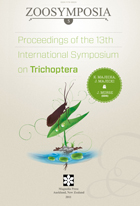Abstract
Structure of the antennal segments and ultrastructure of the sensilla in representatives of Phryganeidae and Limnephilidae have been investigated using scanning electronic microscopy (SEM) and optical microscopy. Twelve types of antennal sensilla have been observed and their preliminary classification based on cuticular structures is discussed. All types of sensilla are unevenly distributed on the surface of the antennal flagellum. The most characteristic feature is the presence of specialized sensory fields on the antennal segments (flagellomeres). These are the depressed ventral areas in the apical parts of flagellomeres in all Phryganeidae and Dicosmoecinae (Limnephilidae) and the elongate ventrolateral areas in more advanced Limnephilidae from the subfamilies Stenophylacinae and Limnephilinae. In contrast to the lower Dicosmoecinae with a wide variety of pseudoplacoid sensilla, the antennal surfaces of both sexes in the subfamilies Limnephilinae and Stenophylacinae have only specialized, dentate, small pseudoplacoids. These data suggest internal heterogeneity in the family Limnephilidae, where Dicosmoecinae have very different antennal structures, and support an hypothesis of separate status for Dicosmoecinae. The families Phryganeidae, Plectrotarsidae and Goeridae have only the forked sensilla while Apataniidae and Brachycentridae only mushroom-like pseudoplacoids. Comparison to representatives of Rhyacophilidae, Molannidae, Hydropsychidae, and Leptoceridae indicates that there are significant variations in the sensory structures of Trichoptera antennae. Functional aspects of the antennal structures in relation to the behavior interaction with the air currents are discussed.

